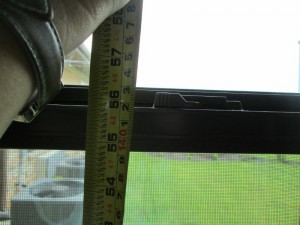Operable Windows
Posted on - Monday, February 2nd, 2015The 2010 ADA introduced new scoping for operable windows. If there are operable windows in a space that will be operated by the user, at least one operable window in that space must be accessible (i.e. meet the requirements in 308 and 309)
That seems simple enough until you start specifying what type of window meets the requirements. This newsletter will try and explain the requirements and give you some suggestions on where to find windows that meet the requirements.
ADA 229: Scoping for Windows
According to section 229 of the ADA, operable windows (if provided) will have to comply with section 309 (and 308).
2010 ADA 229.1 General. Where glazed openings are provided in accessible rooms or spaces for operation by occupants, at least one opening shall comply with 309. Each glazed opening required by an administrative authority to be operable shall comply with 309.

In addition to the requirement to comply with section 309, the scoping above states, if there are operable windows in the space, at least one shall comply. But it also states that “Each glazed opening required by an administrative authority to be operable shall comply with 309.”
An example of an administrative authority that will require operable windows in spaces is The Department of Aging and Disability Services (DADS) that is in charge of long term care facilities, such as assisted living, skilled nursing and memory care facilities. DADS requires that one operable window be provided at each bedroom or sleeping room.

Windows that are operated by staff for work purposes are not required to comply with ADA.
Operable Parts
Section 309 requires that a clear floor space be provided at the element that requires operation. In addition, the operable part must be mounted no lower than 15″ a.f.f. and no higher than 48″ a.f.f. per ADA section 308




Heights to operable parts that meet the accessible reach ranges might be difficult to achieve since there are also requirements for minimum sill heights that might need to be maintained for other codes and standards. Specifying windows with operable parts that are at the bottom portion of the window might help to achieve the heights.
The third requirement of operable parts is listed below:
309.4 Operation. Operable parts shall be operable with one hand and shall not require tight grasping, pinching, or twisting of the wrist. The force required to activate operable parts shall be 5 pounds (22.2 N) maximum.
Section 309 applies to all controls and operating mechanisms, so the latch must comply with the requirement to operate with no more than five pounds of force (5 lbf). This requirement is not only to open, but to unlatch and close also.
Samples of Manufacturers that meet the requirements
Out of all the types of windows that are available for commercial use, there are only two types that are able to meet the requirements in section 309. Those are are the casement windows and awning windows

The operation is tested by the American Architectural Manufacturer Association (AAMA 513-14). Not all window manufacturers provide models that meet the reqiurements, but I was invited to a seminar where three companies presented their models:
Wausau: Aluminum casement and awnings
Graham: Aluming casement and awnings
Milgard: Vinyl awning
There are also after market devices that can be installed onto windows, including hung windows, which reduces the force required to open them to less than 5 lbs of operation. Some of these are:

Fenstrator by Mighton: Watch this video about how it works


Upcoming Continuing Education Opportunities
We will be presenting at the 2015 National AIA convention in Atlanta. Our class will be all about Existing and altered facilities.
If you are interested in getting a Barrier Free/ADA CEU online, I partnered with Green CE. We will be presenting live webinars this year. We will post details as they become available
If you are interested in Building Code seminars check out my colleague Shahla Layendecker with SSTL Codes
If you want to learn more about these standards, be sure to check out my books:
“The ADA Companion Guide” “Applying the ADA” published by Wiley.


They are available for sale now. (also available as an e-book)
If you have any questions about these or any other topics, please feel free to contact me anytime.
Marcela Abadi Rhoads, RAS #240
Abadi Accessibility
214. 403.8714
marhoads@abadiaccess.com
www.abadiaccess.com
 Abadi
Abadi 


